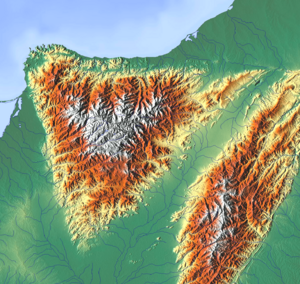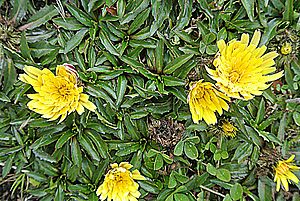Santa Marta páramo facts for kids
Quick facts for kids Santa Marta páramo (NT1007) |
|
|---|---|
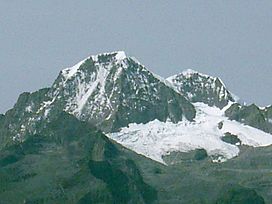
Pico Cristobal Colon
|
|
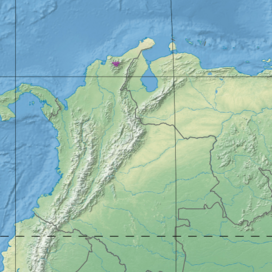
Ecoregion territory (in purple)
|
|
| Ecology | |
| Realm | Neotropical |
| Biome | Montane grasslands and shrublands |
| Geography | |
| Area | 1,295 km2 (500 sq mi) |
| Countries | Colombia |
| Coordinates | 10°49′37″N 73°40′01″W / 10.827°N 73.667°W |
| Climate type | Cwb: warm temperate, winter dry, warm summer |
The Santa Marta páramo (NT1007) is a special type of high mountain area found in the Sierra Nevada de Santa Marta mountains in Colombia. It's located on the Caribbean coast. A páramo is like a high moorland, with unique plants and animals that live above where trees can grow.
Because these mountains are so isolated, many unique species have developed here. Some of these species are similar to those found in Central America or the Caribbean. Others are related to species from the Andes mountains. Even though this habitat is quite stable, human activities over a long time have changed it a lot.
Contents
Exploring the Santa Marta Páramo
Where is the Santa Marta Páramo?
The Santa Marta páramo covers a large area of about 129,499 hectares (that's about 320,000 acres!). It sits high up in the Sierra Nevada de Santa Marta mountains in northern Colombia.
This mountain range looks roughly like a triangle. Its northern side runs along the Caribbean Sea. The southwest side faces the big swamps of the Ciénaga Grande de Santa Marta. The southeast side looks towards the Serranía del Perijá mountains, separated by the Cesar and Ranchería river valleys.
The Santa Marta páramo is surrounded by other unique areas. Below it are the Santa Marta montane forests. These forests are then surrounded by drier areas like the Sinú Valley dry forests and the Guajira–Barranquilla xeric scrub.
What is the Land Like?
The Santa Marta páramo is the most northern páramo in all of South America. The Sierra Nevada de Santa Marta mountains are very tall, reaching up to 5,775 meters (about 18,947 feet) high.
The páramo itself is found between the treeline, which is around 3,300 meters (about 10,827 feet) high, and the snowline, which is around 5,000 meters (about 16,404 feet). The exact height can change a bit depending on the slope, how much rain falls, and how much wind and sun an area gets. Most of this area is made of a type of rock called granodiorite, which formed during the Jurassic period.
What is the Climate Like?
The climate here is called "Cwb" by scientists. This means it's a warm temperate zone with dry winters and warm summers.
Other páramos, like the Northern Andean páramo, are usually wet all year round. They get a lot of rain, clouds, and fog as air moves up the mountains. But the Santa Marta páramo is different. It's more like the Costa Rican páramo or the Cordillera de Merida páramo. Here, the northeast trade winds create a clear dry season.
Even so, moist air rises every day, bringing mist and rain. Most of the rain falls in May and September.
For example, in one spot, the average monthly temperatures range from about 11.4°C (52.5°F) in January to 13.8°C (56.8°F) in June. The average yearly temperature is around 13°C (55.4°F). The lowest average temperature is about 8°C (46.4°F), and the highest is about 18.5°C (65.3°F).
The average total rainfall is about 1,800 millimeters (about 71 inches) per year. Monthly rainfall changes from about 33.3 millimeters (1.3 inches) in January to 245.2 millimeters (9.6 inches) in May. It then drops to 115.2 millimeters (4.5 inches) in July before rising again to 304.5 millimeters (12 inches) in October.
Life in the Santa Marta Páramo
The Santa Marta páramo is part of the Neotropical realm, which includes many parts of Central and South America. It belongs to the montane grasslands and shrublands biome, meaning it's a high-altitude area with grasses and shrubs.
This ecoregion is part of a larger group called the Northern Andean Paramo. This group also includes other páramos like the Cordillera Central páramo and the Cordillera de Merida páramo. The plants and animals here are specially adapted to live in the cold, dry conditions of these high mountains.
Many species found here are endemic, meaning they live nowhere else in the world. This is especially true for species on the more isolated mountain peaks. The Sierra Nevada de Santa Marta has even been named a Biosphere Reserve because of its unique plants and animals, especially those found at higher elevations.
How Did Life Here Begin?
The Andes mountains started to form millions of years ago. But in the northern part, they didn't reach their current height until about four to five million years ago. This was a time of strong volcanic activity.
When the land rose above the treeline, the first páramo plants began to grow. These included new types of grasses (Poaceae), sedges (Cyperaceae), and plants from the daisy (Asteraceae) and heather (Ericaceae) families.
Later, during the Quaternary period, the climate kept changing. There were cold, dry periods (ice ages) and warmer, more humid periods. During the cold times, the páramo areas would spread lower down the mountains and connect with each other. When it got warmer, they would move higher up, becoming separate "islands" of habitat.
This history has led to a mix of species. Some are from tropical areas, and some are from colder, northern areas. Many plant groups are found in most páramos, but there are also many unique species found only in individual páramos.
The Santa Marta páramo is very isolated, which means it has a truly unique mix of plants and animals. Its isolation has allowed special endemic species to evolve, like the plant groups Castenedia and Raouliopsis.
These species developed from warm tropical plants that were used to wet conditions. They also came from Andean species that traveled along the eastern mountain range of Colombia. The plants here are more similar to those in the Cordillera de Merida páramo and the Cordillera de la Costa montane forests than to the main Northern Andean páramo.
Scientists believe the plants here came from species that grew at medium heights millions of years ago. They then changed and became unique as the land was lifted to very high elevations during the Pliocene and Pleistocene periods.
In 2013, a study looked at how similar the unique plants were in different páramo areas in Colombia. It found that these areas naturally formed five main "biogeographical provinces." This means that the Santa Marta páramo and the Perijá páramo are actually more similar to the Páramos de Chirripó in Central America than to the rest of the Northern Andean páramo. This is true even though they are separated by the Cesar River valley.
Amazing Plants of the Páramo
The páramo is home to high-altitude tussock grasslands, thickets, bogs, and marshes. The plants on the northern side get more rain and are tougher than those on the southern side, which are protected from the strong trade winds.
Scientists have found 125 species of flowering plants (angiosperms) that are unique to the Sierra Nevada. Of these, 61 are found only in the páramo! There are also 135 different groups (genera) of vascular plants recorded here.
Two plant groups, Raouliopsis and Obtegomeria, are found only in this páramo. The plant group Pentacalia has 8 of its 11 unique species growing only in the páramo. Similarly, Diplostephium has 9 of its 10 unique species found only here. Other plant groups with species unique to the páramo include Micropleura, Niphogetum, Perissocaelum, and Cotopaxia.
The plants grow in different "strips" or zones depending on the elevation:
- The lowest strip, called "subpáramo," is along the edge of the forest. It has more shrubs. Plants here include Calamagrostis effusa, Arcytophyllum nitidum, Stevia lucida, Escallonia myrtilloides, and Hesperomeles lanuginosa.
- The middle strip is the "true páramo." It has more open shrublands with low shrubs. Open areas have plants like Acaena cylindrostachya, Castilleja fissifolia, and Lupinus carrikeri. Shrubs found in protected valleys and on rocky slopes include Alchemilla polylepis, Simplocos nivalis, and Obtegomeria caerulescens. Swamps and the edges of glacial lakes have clumps of Azorella crenata and rosettes of Hypochaeris sessiliflora. Water plants include Callitriche nubigena and Ranunculus limoseloides.
- The highest strip is the "superpáramo." It has scattered clumps of grass. You can find patches of Raouliopsis seifrizii and Draba sanctae-marthae here. Areas protected from the wind have Valeriana karstenii and Perissocaelum purdiei.
Amazing Animals of the Páramo
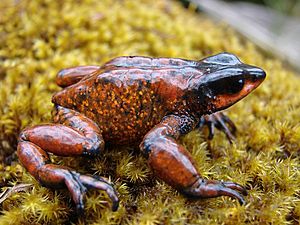
The Santa Marta páramo is home to many unique animals. Some mammals found only here are special types of the red brocket deer (Mazama americana carrikeri) and the cougar (Puma concolor bangsi).
Sadly, some amphibians (like frogs and toads) are endangered here. These include Atelopus arsyecue, the Guajira stubfoot toad (Atelopus carrikeri), and Boulenger's backpack frog (Cryptobatrachus boulengeri).
Birds you might see include the majestic Andean condor (Vultur gryphus), the rufous-collared sparrow (Zonotrichia capensis), and Jameson's snipe (Gallinago jamesoni). Two birds that are endangered and found only here are the Santa Marta bush tyrant (Myiotheretes pernix) and the black-backed thornbill (Ramphomicron dorsale).
Protecting the Páramo
The World Wide Fund for Nature (WWF) says the Santa Marta páramo is "Relatively Stable/Intact." This means it's still in pretty good shape. In fact, the páramo is actually growing! This happens because the Andean forests at lower levels are being cleared, and the glaciers at the very top are shrinking.
The ecoregion is protected by the Sierra Nevada de Santa Marta National Park. This park helps keep the area safe.
The Kogi, Arsario, and Arhuaco are indigenous (native) people who live here. Their populations are growing, and they have special reserves that cover parts of the páramo. They also have special rights within the national park.
However, their activities do affect the páramo. They graze large herds of cattle and sheep up to heights of 3,800 meters (about 12,467 feet). They also hunt cougars and condors to protect their livestock. They cut down wood for fuel and building materials. In the lower páramo (subpáramo), they have expanded the scrublands by burning them and grow crops like potatoes and onions.
These changes can reduce the number of different species (biodiversity), change the balance of plants, and increase erosion (when soil is washed away). It's a challenge to balance human needs with protecting this unique environment.
See also
 In Spanish: Páramo de Santa Marta para niños
In Spanish: Páramo de Santa Marta para niños


